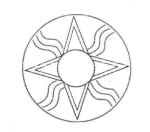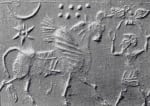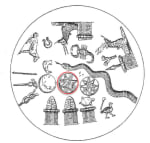Nibiru (Planet X)
Anyone familiar with Ancient Aliens, Coast to Coast AM,or internet conspiracy talk about the end of the world will recognize the terms “Nibiru” and “Planet X.” The two names are interchangeable, as they are names for the same alleged planetary object that will supposedly pass close to earth in the early 21st century, so close that it will cause earthly cataclysm. At least that’s what to expect according to Nancy Lieder, who channeled the information from aliens.

The Planet X hypothesis was not birthed by scientific inquiry nor supported by planetary science. It is also not the brainchild of Lieder, who basically appropriated the idea from others, namely the late Zecharia Sitchin, famous for his ancient astronaut theories.
According to Sitchin, ancient Mesopotamian texts describe a planetary body named Nibiru whose location is normally beyond Pluto. Nibiru is the home planet of the Anunnaki, an alien race that visited earth in great antiquity and created humanity via genetic modification of primates. Sitchin claimed that the cuneiform texts of ancient Sumer and Akkad reveal that Nibiru passes through our solar system every 3600 years. Nibiru is allegedly due to pass near earth soon (the dates offered have been changing since 2003 each time the prophecy is incorrect).
Is Sitchin correct – Is Nibiru a twelfth planet that passes through our solar system every 3600 years? Did the Sumerians know this?
Nibiru (Planet X): What Do the Ancient Tablets Say?
There are many Sumerian-Akkadian astronomical tablets. The popular conspiratorial ideas about Nibiru / Planet X aren’t based on any of the primary source material. In fact, the primary source material contradicts the claims in insurmountable ways.
According to the monumental Chicago Assyrian Dictionary(= CAD), a resource that accounted for the known occurrence of the word “nibiru” (or neberu), the term means “crossing” or some sort of “crossing marker” or “crossing point.” The word occurs in several astronomical texts associated with two differentplanets: Jupiter and Mercury. It is also called (more vaguely) a “star,” and is further associated with the deity Marduk. Nibiru is never identified as a planet beyond Pluto, nor is it ever associated with the Anunnaki gods of Sumerian-Mesopotamian religion.
Of particular relevance is the series of astronomical tablets called Enuma Anu Enlil(EAE). The EAE is a series of 68-70 tablets (depending on how they are collated) that deal with Babylonian astronomy-astrology. Quoting Francesca Rochberg (p. 1929), Heiser summarizes the relevant data from EAE related to Nibiru:
Rather than a concern with lunar visibility, the astrolabes are concerned with the “variation in length of daylight throughout the year.” The main content of the astrolabes is a “fixed star calendar in which months of heliacal risings are given for three fixed stars in each of the twelve months in a schematic year.” Hence the “three stars each” name for these tablets. In other words, three fixed stars were observed each month as to the point / time of their appearance over the horizon just prior to the sun’s appearance. These stars “[were] further assigned to three ‘paths’ in the sky, named for the three great gods Anu, Enlil, and Ea. The paths were defined with respect to the eastern horizon and represent areas of the sky in which one sees stars rise in seasonal regularity (one of the chief differences between them and the planets). The attempt to place the stars in the sky and to describe their cyclical return to their place accounts for the modern title ‘Astrolabe’. . . . The fact that these stars in the astrolabe are all “fixed” may suggest that since Nibiru is described as Marduk-Jupiter and also Mercury in one text, and yet “changes course” . . . , this shows that the fixed star of Nibiru may have changed position, depending on when its observation in the various texts was made.”
The point to note is that Nibiru is referred to as a fixed star that can be observed every year.Hence the idea of a 3600-year orbital path is simply not in agreement with the cuneiform tablets themselves. The idea is a modern invention.
The reality of the data is very straightforward. Mesopotamian astronomical texts never refer to any planetary body beyond Saturn. The reason is simple: Saturn is the most remote planet visible via naked-eye astronomy. If we use the Sumerian-Akkadian source material instead of modern ancient astronaut theory (or channeling aliens) there is no Planet X beyond Pluto called Nibiru.
Nibiru (Planet X): Cylinder Seal VA243
Supporters of the Nibiru / Planet X hypothesis would ignore the lack of data from the cuneiform texts and offer a cylinder seal impression made famous by Zecharia Sitchin as proof of a twelfth planet. Despite the indisputable fact that no Sumerian-Akkadian astronomical text knows of any planet beyond Saturn, the seal image convinces many that the ancient Sumerians were given knowledge by the Anunnaki aliens of planets beyond Saturn.
 Figure 1
Figure 1
This seal is known to scholars as VA 243 (it is number 243 in the collection of the Vorderasiatische Museum in Berlin). This seal is the centerpiece of Sitchin’s theory that the Sumerians had advanced astronomical knowledge of the planetary bodies in our solar system. In the upper left-hand corner of the seal we see an alleged depiction of the sun surrounded by eleven globes. Since ancient peoples (including the Sumerians according to Sitchin) held the sun and moon to be “planets,” these eleven globes plus the sun add up to twelve planets. Of course, since we now know of nine planets plus our sun
 Figure 2
Figure 2
and moon, part of Sitchin’s argument is that the Sumerians knew of an extra planet beyond Pluto.
A study of Mesopotamian art and iconography for the sun reveals that Sitchin’s understanding of this seal is deeply flawed. The object he and his followers believe is the sun is not the sun, as it fails to conform to how the sun was depicted on numerous objects. The sun is consistently depicted with wavy lines extending from its center (Figure 2). Stars are depicted like the object in the cylinder seal (globular center with pointed “arms”) or as dots (see the seven dots/stars of the Pleiades in Figure 3).
 Figure 3
Figure 3
 Figure 4
Figure 4
In the zodiac artwork known from the Babylonian kudurrureliefs (Figure 4), the encircled object is the sun—depicted along with the symbol for the moon and the stars.
It is important to notice that VA243 (Figure 5) has writing on it. There are several short Sumerian inscriptions on the seal. None of these inscriptions validates Sitchin’s notion about twelve planets. The inscriptions are transliterated and translated (in German) in the principal publication of the Berlin Vorderasiatische Museum’s publication of its seal collection, Vorderasiatische Rollsiegel (“West Asian Cylinder Seals”; 1940) by Mesopotamian scholar Anton Moortgat (p. 101):
 Figure 5
Figure 5
Below is the German and an English translation:
Line 1 = dub-si-ga “Dubsiga” [a personal name of an apparently powerful person]
Line 2 = ili-il-la-at “Ili-illat” [another personal name, this time of the seal’s owner]
Line 3 = ir3 -su “dein Knecht” [German for “your servant”]
The inscription is quite pedestrian. It reads: “Dubsiga, Ili-illat, your/his servant.” Nothing in the inscription suggests anything remotely to do with astronomy or planets. VA243 is in no way contradictory to Sumerian-Mesopotamian astronomical texts that unanimously offer no evidence for any planet beyond Saturn.
Resources:
Exposing Pseudo-Astronomy Podcast series on Planet X Fraud
Michael S. Heiser, “The Myth of a Sumerian 12th Planet: ‘Nibiru’ According to the Cuneiform Sources”
Michael S. Heiser, “The Myth of a 12th Planet: A Brief Analysis of Cylinder Seal VA 243”
Wayne Horowitz, Mesopotamian Cosmic Geography (Eisenbrauns, 1998)
Hermann Hunger and David Pingree, Astral Sciences in Mesopotamia (Leiden: E. J. Brill, 1999)
N. Swerdlow, The Babylonian Theory of the Planets (Princeton University Press, 1998)
David Brown, Mesopotamian Planetary Astronomy-Astrology (Groningen: Styx, 2000)
What is your response?


